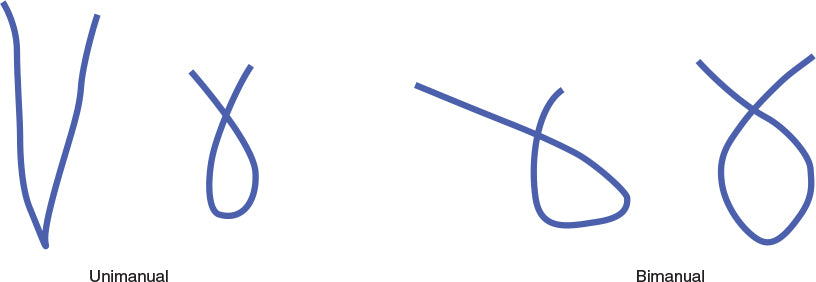Try the y-V experiment
This is an excerpt from Motor Learning and Performance 7th Edition With HKPropel Access by Timothy D Lee,Richard A Schmidt.
Try this simple experiment for yourself. Draw small figures that represent the Greek letter gamma (γ) on a tablet, whiteboard, or sheet of paper taped to your desk. Draw the γ relatively quickly, without modification during its production. The figure must cross over near the center and have a rounded bottom. When you can do this effectively, use the other hand to draw regular Vs. The procedure is the same as before except that now the figure must not cross over itself and must have a pointed bottom. Based on chapter 5, each figure is represented by its own motor program because the temporal structures for the two figures are different: down-up for the V and down-over-up for the γ. Most people do not have any trouble producing these figures when each is drawn on its own, as in the left side of figure 7.2 (unimanual).

Now try to produce these two figures together, using the same hands as before. You will find, as Bender (1987) did, that doing both tasks at the same time is very difficult, with results such as those shown in the right side of figure 7.2 (bimanual). Most people make the same figure with both hands or at least they produce certain features of one of the different figures with both hands (e.g., a rounded bottom). Clearly, the fact that the participants could produce these actions unimanually was evidence that there was a separate motor program available for each. But, even after considerable practice, most people cannot do this dual task effectively. This demonstration indicates that, even with separate programs for producing a V and a γ, these programs cannot be executed independently at the same time.
These findings, together with the results from Kelso and coauthors (1979, 1983) presented in the previous sections, can be interpreted to suggest that the motor system can produce only a single motor program at one time. This is an extension of the idea expressed earlier that the movement programming stage could organize only a single movement at a time, after completion of the other stages. But now the focus is on the production of the movement itself. When two independent programs would be best suited for the upcoming task requirements, instead, the system responds with a hybrid solution that attempts to control both limbs similarly.
More Excerpts From Motor Learning and Performance 7th Edition With HKPropel AccessSHOP

Get the latest insights with regular newsletters, plus periodic product information and special insider offers.
JOIN NOW
Latest Posts
- Authenticity was key to McKinney’s NIL success
- AI—A new tool for sport PR pros
- Essential skills for sport PR practitioners
- Employ these tactics when pitching a story to the media
- How does ergonomic analysis and intervention enhance safety and reduce injury risk?
- Common movement patterns in competitive cycling


